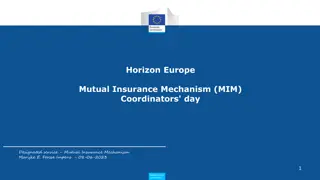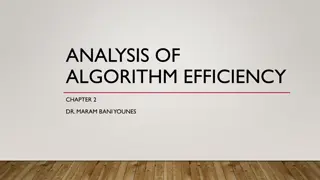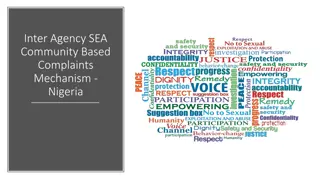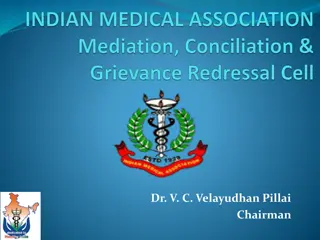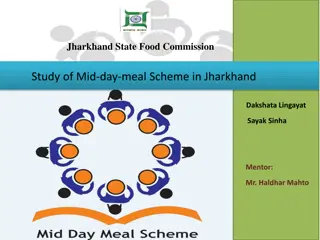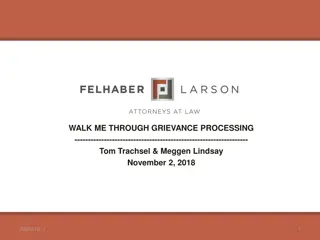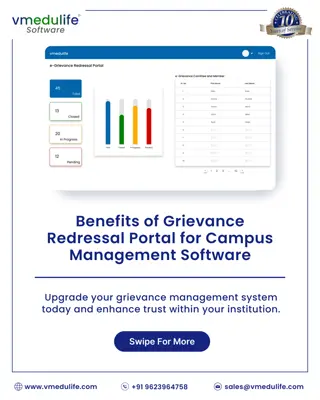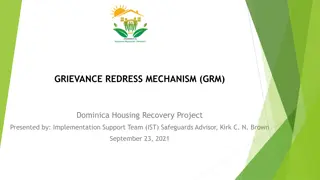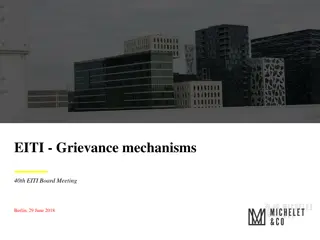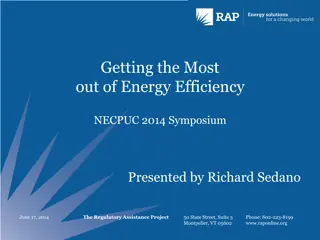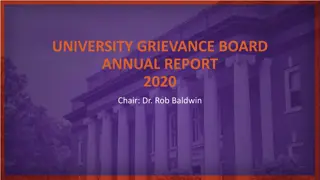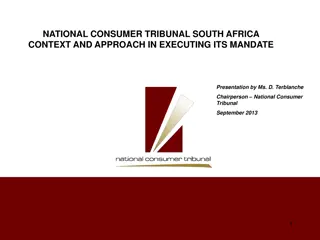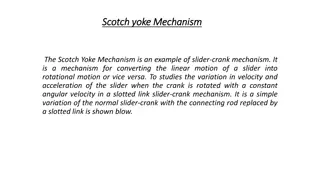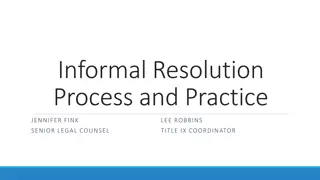Grievance Redress Mechanism: Enhancing Project Efficiency
Understanding the Grievance Redress Mechanism (GRM) is crucial for effective project management. This mechanism aims to address complaints and concerns related to project implementation, ensuring transparency and stakeholder engagement. By sensitizing facility GRM focal persons and following structured processes, projects can enhance operational efficiency, mitigate risks, and improve accountability. A well-designed complaints handling mechanism not only resolves issues but also fosters trust and transparency in project delivery.
Download Presentation

Please find below an Image/Link to download the presentation.
The content on the website is provided AS IS for your information and personal use only. It may not be sold, licensed, or shared on other websites without obtaining consent from the author.If you encounter any issues during the download, it is possible that the publisher has removed the file from their server.
You are allowed to download the files provided on this website for personal or commercial use, subject to the condition that they are used lawfully. All files are the property of their respective owners.
The content on the website is provided AS IS for your information and personal use only. It may not be sold, licensed, or shared on other websites without obtaining consent from the author.
E N D
Presentation Transcript
Grievance Redress Mechanism SENSITIZATION OF FACILITY GRM FOCAL PERSONS
Presentation outline Presentation outline Introduction to grievance redress mechanisms Importance of grievance redress mechanism to a project Types of Grievances and redress outcomes Principles of a good GRM Project grievance handling structures GRM tools Timelines and Reporting GRM contacts at National level Responsibilities and protocols for handling complaints
GRM GRM Covers 47 counties and the National government Focuses on all grievances whether major or minor that have linkage to the project either by what the project is doing or what it is not doing yet it was supposed to do. The GRM has four specific objectives, which are to facilitate: Smooth implementation of the project; Timely and effective resolution of problems; Strengthening stakeholder engagement, trust and transparency; Ensuring that recurring problems are mitigated in future.
What is a grievance? Any concern or dissatisfaction or discontent, with the facility and/or services offered/provided, about actions taken/not taken whether exposed or not, whether valid or not, which the public/employee thinks, believes or even feels to be unfair, unjust or inequitable. J.M. Jucius, Grievance: An official statement of a complaint over something believed to be wrong or unfair. (Oxford English Dictionary) A patient grievance is a written or verbal complaint by a patient, or the patient's representative, regarding the patient's care, abuse or neglect, or issues related to the facility. Medical Grievances specific to medical care or treatment,
Grievance redress mechanisms Grievance redress mechanisms Grievance Redress Mechanism (GRM): A set of structures, procedures and processes by which complaints, queries, clarifications and feedback about a project are responded. It Provides affected people with avenues for making a complaint or resolving any dispute that may arise during the course of the implementation of a project; Ensures that appropriate and mutually acceptable redress actions are identified and implemented to the satisfaction of complainants; and Avoids the need to resort to judicial proceedings
Importance of grievance redress mechanism to a Importance of grievance redress mechanism to a project project A well-designed and implemented complaints handling mechanism significantly enhances operational efficiency in a variety of ways, including Generating public awareness about the project and its objectives; Deterring fraud and corruption; Mitigating risks; Providing project staff with practical suggestions/feedback that allow them to be more accountable, transparent, and responsive to beneficiaries; Increases stakeholder involvement in the project. An effective GRM can help detect problems before they become more widespread, thereby preserving the project reputation specifically
Types of Grievances Real or Imaginary: Expressed or Implied: Visible Grievances or Hidden Grievances: Oral or Written: Disguised Grievances: mental pressure or frustration, other factors and not related to work. Individual or Group Grievances: Union Grievances: on behalf of member employees Policy Grievances: relating to terms of employment
5 Common Patient Complaints in Healthcare Lack of Communication and Dismissiveness Long Wait Times. Issues with Staff Members. Amount of Time Spent with Doctor. Insurance and Billing.
Complaint categories Complaint categories Service delivery related complaints Workers complaints Complaints due to professional negligence GBV/Sexual Exploitation and Abuse (SEA) Environmental and community health hazards Fraud and corruption Complaints from VMG communities Complaints related to socio-economic concerns during COVID 19
Grievance redress outcomes Grievance redress outcomes Negotiated: voluntary agreement between two parties to a dispute. Mediated: voluntary agreement between two parties to a dispute to seek its resolution through the less formal method of mediation by a neutral third party. The ultimate acceptance or rejection of the proposed remedy lies with the disputing parties. Apology: something that you say or write to tell someone that you are sorry that you have hurt them or caused trouble for them. This is with or without reference to mitigating circumstances. Award: This means that the complainant(s) is accorded some compensation
Principles of Effective GRMs Principles of Effective GRMs Fairness : Grievances should be handled confidentially, assessed impartially, and managed transparently. Objectivity and independence : The GRM should operate independently of all interested parties in order to guarantee fair, objective, and impartial treatment to each case. GRM officials should have the means and powers to investigate grievances (e.g., interview witnesses, access records). Simplicity and accessibility : Procedures to file grievances and seek action should be simple enough for project beneficiaries to understand them. The GRM should be accessible to all stakeholders, irrespective of the remoteness of the area they live in, the language they speak, and their level of education or income.
Principles of Effective GRMs Responsiveness and efficiency- The GRM is designed to be responsive to the needs of all complainants. Accordingly, officials handling grievances are trained to take effective action upon, and respond quickly to, grievances and suggestions. Speed and proportionality- All grievances, simple or complex, are addressed and resolved as quickly as possible. The action taken on the grievance or suggestion is swift, decisive, and constructive. Participatory and social inclusion- Special attention is given to ensure that poor people and marginalized groups, including those with special needs, are able to access the GRM.
What does a GRM typically look like? Receive and register grievance Acknowledge, Assess, Assign Develop a proposed response Communicate proposed response to complainant and seek agreement on the response Implement the response to resolve the grievance Review the response if unsuccessful Close out or refer the grievance
GRM Value Chain Uptake - How are grievances collected? At how many locations and through what channels? What is the organizational structure for grievances handling? Sorting and Processing How are grievances categorized, logged and prioritized? Who are they referred to? How are they addressed? Acknowledgement and Follow Up Are complainants provided receipts? How are they provided progress updates? Verification, Investigation and Action How is information about the grievance gathered to resolve it? How are grievances escalated to higher levels? Monitoring and Evaluation How are grievances tracked? How is grievances data analyzed? How are processes modified to prevent grievances from recurring? Feedback How are GRM users and the public at large informed about the results of investigations and the actions taken on grievances?
GRM Dos and Donts 1. Uptake Dos Create accessible uptake locations and channels Maintain log books at various levels to record all complaints, inquiries, and suggestions received. Publicize uptake options/contact information on communication materials, in offices, etc. Create barriers to complaining by making uptake processes time consuming or complicated Forget to take measures to ensure that vulnerable groups are able to access the GRM Don ts 15
GRM Dos and Donts 2. Monitor and evaluate Dos Signal importance of complaints handling putting topic as agenda item for management meetings Establish a tracking system to record, classify, and assess complaints Analyze grievance redress data and make improvements Don ts Miss the opportunity to integrate the GRM into the project s management information system View the resolution of complaints as an end in itself it is just a first step in improving processes 16
GRM Dos and Donts 3. Sort and process Dos Clearly outline who is responsible for handling different types of complaints Establish clear timetables for the complaints-handling process Assign each complaint a unique ID number Don ts Leave any ambiguity about how complaints are supposed to be routed Develop a GRM that does not differentiate between different types of complaints 17
GRM Dos and Donts 4. Provide feedback Dos Contact users to explain how their complaint was resolved and how they can appeal Publicize results of investigations to enhance visibility of and increase trust in the GRM Don ts Neglect to follow up with users; this undermines trust in the GRM Keep complaint results private; this undermines transparency 18
Steps in Setting Up a Basic GRM Steps in Setting Up a Basic GRM GRM Area Activities Assign a specific email id, phone number. Set up an easy to access "Suggestion/Grievance box . Designate a grievance officer to receive, log, monitor or track grievances Modify the project website (if any) to create a permanent sub-window that facilitates collection of complaints. Complaint Receipt Suggest timeframes and procedures to receive, log, monitor or track complaints and respond to complainants. Assign grievance resolution responsibilities to existing staff Complaint Processing Design a simple, easy to use, excel-based or log-book based complaint registration and monitoring database Regularly review feedback received, cases resolved and complaints trends in resettlement review meetings. Monitoring and Tracking Complaints
Grievance Identification Methods Direct observation Suggestion box system, Opinion surveys, morale survey, attitude survey, job satisfaction survey, and grievance survey, Open-door policy. encourage upward communication and keep their doors open physically and psychologically. Exit interview
Procedure for Handling complaints Listen.. ... Give every grievance due respect and consider important Empathize. Place yourself in the patient's place. ... Inquire. ... Gather facts and maintain their proper records should be in writing Act. ... Make a list of all options,solutions, evaluate them on their effect Conclude. ... Communicate decision reached. Make follow-up on action taken Document.
Essentials of a Good Grievance Redressal Essentials of a Good Grievance Redressal System Timely Action System: Acknowledgement of Grievance. Identifying the Problem Diagnose the problem. Collecting Facts relevant facts and profile relating to the grievance. Analyzing the Cause root of the problem. Taking Decision Alternative courses of action suited to a given situation Implement the Decision Communicate to the grievant and implemented by the authority.
Some common errors are: Stopping too soon in the search of facts Expressing a management opinion before all the pertinent facts have been discovered Failing to maintain proper records Resorting to management facts instead of discussing the facts of public/employee grievance and attempting to change minds Communicating the decision to the grievant in an improper manner Taking wrong or hasty decision, which the facts of the case do not justify.
RESPONDINGTOGRIEVANCES-TIPS Most complaints can be resolved quickly and satisfactorily by: 1. Dealing with complaints in person; 2. Apologizing for inadvertent breaches; 3. Rectifying root causes; 4. Assuring complainants that their complaint will be treated seriously and future preventative action will be instituted where possible. 5. Ensure trustworthy, empathetic and fair people deal with complaints; 6. Train staff in complaints handling skills for all staff: listen, empathize and calm. Never dismiss or insult people. 7. Complaints are positive as they give an opportunity to improve the project and see where priority needs are. 8. ANYONE MAY RECEIVE A COMPLAINT 9. ENSURE CONFIDENTIALITY AND WHISTLE BLOWER PROTECTION 2 4
Grievance Prevention Provide sufficient and timely information to communities.- Many grievances arise because of misunderstandings; lack of information; or delayed, inconsistent, or insufficient information. Conduct meaningful community consultations. Build capacity for project staff, particularly community facilitators and other field- level staff.
Group Exercise 1.What mechanisms do you have in place: a. At health centre level; b. Sub county level c. County level 2. Who are the focal persons at each level? a. Have they received an orientation in receiving/logging/resolution and referral? If not when can you do this? b. Have you raised awareness among the community about the GRMs at the 3 levels? How/when with whom? If not, how can you do this. c. Any challenges or suggestions to strengthen the GRM?




